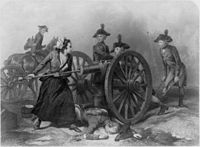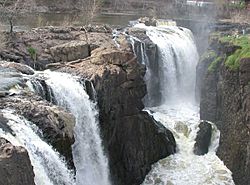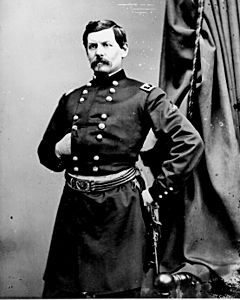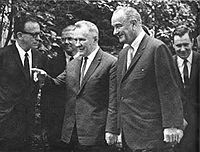History of New Jersey facts for kids
Quick facts for kids History ofNew Jersey |
|
|---|---|
 |
|
| Colonial period | |
| American Revolution | |
| Nineteenth century | |
| Twentieth century | |
| Twenty-first century | |
| Timeline of New Jersey | |
The history of what is now New Jersey began around 15,000 years ago. At that time, Native Americans moved into the area as a huge ice sheet melted away from northern New Jersey.
European explorers first arrived in 1524, when Giovanni da Verrazzano explored the Jersey Shore. Many Lenape tribes lived in the area when Europeans first came.
In the 1600s, the New Jersey region was controlled by the Swedes and then the Dutch. But in 1664, the English took over the Dutch colony, renaming it the Province of New Jersey. New Jersey became one of the Thirteen Colonies that fought for independence from Britain in the American Revolution. It adopted the Declaration of Independence in 1776. New Jersey played a big role in the American Revolutionary War. It became a state when the United States was formed. New Jersey's leaders signed the Articles of Confederation in 1779, and Princeton was even the nation's capital for four months in 1783.
In 1787, New Jersey was the third state to approve the U.S. Constitution.
During the 1800s, New Jersey cities led the Industrial Revolution in the United States. The state also sent 88,000 soldiers to the American Civil War. New Jersey was part of the Underground Railroad, a secret network that helped enslaved people escape to freedom. Transportation improved with new canals and railroads, helping industries grow. New Jersey did well in the early 1900s, but its economy struggled during the Great Depression in the 1930s. In World War II (1939-1945) and the Cold War (around 1947-1991), New Jersey's shipyards and military bases were very important for U.S. defense. In the 1960s, New Jersey faced social challenges and hosted the Glassboro Summit Conference (1967) between U.S. President Lyndon B. Johnson and Soviet Premier Alexei Kosygin.
Contents
Early People and Native Americans
New Jersey was first settled by Paleo-Indians after the last big glacier melted around 13,000 B.C. Their campsites have been found in places like Montague and Franklin Township. These early people were hunter-gatherers. This means they hunted animals and gathered plants for food. They moved often to find new food sources.
Later, other Native American groups settled in New Jersey. Around the year 1000, the Lenape people arrived. They are also known as the Delaware Indians. The Lenape were organized into loose family groups. They moved with the seasons at first. But after the bow and arrow and pottery were invented around 500 A.D., they started staying in areas longer. They grew crops like corn, beans, and squash together. They also hunted with bows and arrows and used traps. In the fall, they gathered nuts like acorns and walnuts. Native Americans and Paleo-Indians also fished in rivers and streams using nets, hooks, and their hands. Their Algonquian language gave many names to places across the state.
European Exploration and Early Settlements
In 1524, Giovanni da Verrazzano, sailing for France, explored the coast of New Jersey. He saw places like Sandy Hook and The Narrows. In 1609, Henry Hudson, sailing for the Dutch, explored the East Coast. He explored the Delaware, Raritan, Newark, and New York bays. Over the next four years, Adriaen Block explored and mapped the coast. He named the area New Netherland.
Dutch and Swedish Colonies
Between 1611 and 1614, Dutch explorers mapped the area they called New Netherland. At first, they built small trading posts for furs. In 1624, about 30 Dutch families settled in the region. One of the first European settlements in New Jersey was Fort Wilhelmus on the Delaware River. Later, Fort Nassau was built.
Another Dutch settlement started in 1630 at Paulus Hook, across the Hudson River from Manhattan. This area was bought from the Lenape people. The settlement grew slowly because of problems with the Dutch West India Company and conflicts with Native Americans. In 1658, Peter Stuyvesant, the Dutch leader, bought the entire Bergen Neck peninsula. In 1661, he gave a charter to the village of Bergen, making it the oldest town in the state. The British took over in 1664, ending New Netherland. However, northern New Jersey kept a "Dutch" feel for many years.
Part of southwestern New Jersey was settled by the Swedes in the mid-1600s. This colony was called New Sweden. It grew under Governor Johan Björnsson Printz (1643–53). Printz built Fort Nya Elfsborg near modern-day Salem. This helped protect the area from the English and Dutch. The Swedish and Finnish settlers generally lived peacefully with their Dutch and Lenape neighbors. Old log cabins like the C. A. Nothnagle Log House still show this early influence.
Province of New Jersey
The Dutch colony of New Netherland caused problems for Britain's trade. So, the British King granted the land that is now New Jersey to the Duke of York. In September 1664, a British fleet took over the colony with little fighting. The British renamed the area west of the Hudson River "New Jersey." It was named after the English Channel Island of Jersey. The city of New Amsterdam became New York.
The Duke of York then gave the land that became New Jersey to two friends: Sir George Carteret and Lord Berkeley of Stratton. They were called the "proprietors." They wanted more settlers to come to New Jersey. So, they offered land and passed a document called the Concession and Agreement. This document promised religious freedom to everyone in New Jersey. In return for land, settlers paid yearly fees called quitrents. The proprietors appointed Philip Carteret as the first governor. He made Elizabethtown the capital.
Collecting these fees was hard for the proprietors. So, in 1674, Lord Berkeley sold his share of New Jersey to the Quakers. This sale split the province into East Jersey and West Jersey. The exact border between them was often debated.
Many colonists in New Jersey became farmers. However, farming was tough because there wasn't much English money. Some colonists owned slaves or had indentured servants work for them. Most people lived in simple log cabins. Because New Jersey was near the Atlantic Ocean, colonists farmed, fished, and traded by sea. Travel was slow, usually on foot or horseback. Education came from small religious schools or private teachers.
On April 15, 1702, East and West Jersey were joined back together as a royal colony under Queen Anne. Edward Hyde, Lord Cornbury, became the first royal governor. He was not a good leader and was recalled to England in 1708. For a while, New Jersey was ruled by the governors of New York. But New Jersey settlers were unhappy about this. Judge Lewis Morris argued for a separate governor and was appointed in 1738. From 1701 to 1765, New Jersey and New York also had arguments over their border, leading to small fights.
In 1746, the College of New Jersey (now Princeton University) was founded in Elizabethtown. It moved to Princeton in 1756.
American Revolution in New Jersey
New Jersey was one of the original thirteen colonies that fought for independence from Great Britain. Many settlers in New Jersey remained loyal to the British king. Some slaves also sided with the British, hoping for freedom. The governor of New Jersey, William Franklin, was a loyalist.
On July 2, 1776, New Jersey wrote its first Constitution. This set up the state government. It allowed "all inhabitants of this Colony, of full age, who are worth fifty pounds" to vote. This included non-white people and widows. However, married women could not own property. The Constitution said it was temporary and would be void if peace was made with Britain. Just two days later, on July 4, 1776, five representatives from New Jersey signed the Declaration of Independence.
New Jersey is called the "Crossroads of the Revolution" because many important battles were fought there. More than any other colony, New Jersey saw hundreds of smaller fights. Five major battles happened at Trenton, Princeton, Monmouth, Union, and Springfield. The Battles of Trenton and Princeton are known as the "Ten Crucial Days." These victories were desperately needed and greatly boosted the spirits of the American soldiers.
On the night of December 25–26, 1776, the Continental Army, led by General George Washington, famously crossed the Delaware River. This event was captured in the famous painting Washington Crossing the Delaware. In the Battle of Trenton that followed, American soldiers surprised the Hessians (German soldiers fighting for the British). They captured almost 900 prisoners and valuable supplies in just 90 minutes. After this win, Washington led his army back into Pennsylvania.
A few days later, British General Charles Cornwallis tried to trap Washington's army at Trenton. This led to the Second Battle of Trenton. Americans fought from strong defenses and caused many British casualties. Then, the Continental Army secretly slipped past Cornwallis's army. They attacked British soldiers at Princeton in the Battle of Princeton on January 3, 1777. The British at Princeton had to surrender. These American victories forced the British to leave New Jersey.
On June 28, 1778, Washington's army met a British force led by Sir Henry Clinton at the Battle of Monmouth. Washington hoped to surprise the British. General Charles Lee led the American attack but retreated too early. This almost caused chaos, but Washington rallied his troops. They held off two British attacks. Many soldiers suffered from heatstroke as temperatures reached over 100°F. After the battle, Charles Lee was criticized for his poor leadership. The British had over 1,000 casualties, while the Americans lost 452 men. It was during this battle that the legendary "Molly Pitcher" is said to have fought.
The last major battle in New Jersey during the Revolutionary War was the Battle of Springfield. The Hessian general, Baron von Knyphausen, hoped to invade New Jersey. He wanted to reach Hobart Gap to attack American headquarters in Morristown. On June 23, 1780, the British attacked American soldiers led by Nathanael Greene. General Greene successfully stopped the British invasion.
New Jersey approved and signed the Articles of Confederation on November 26, 1779. In the summer of 1783, the Continental Congress met at Princeton University. It had to move from Philadelphia, Pennsylvania, because of rebellious troops. Princeton became the temporary capital for four months. During this time, the Continental Congress learned that the war had ended with the signing of the Treaty of Paris on September 3, 1783. On December 18, 1787, New Jersey became the third state to approve the U.S. Constitution. On November 20, 1789, it was the first state to approve the United States Bill of Rights.
New Jersey helped shape the new U.S. Government. When Virginia suggested a plan for representation based on state population, smaller states worried they wouldn't have a voice. William Paterson of New Jersey proposed the New Jersey Plan. This plan gave each state one vote, ensuring equal representation. The Great Compromise combined both ideas, creating two parts in the Congress: the House of Representatives (based on population) and the Senate (equal votes per state).
New Jersey in the 1800s
Industrial Growth
New Jersey's economy was mostly based on farming. But poor soil and crop failures made farming difficult. Later, in the 1850s, surveys helped improve farming methods. As farming became less reliable, many New Jerseyans turned to factories and industries.
Paterson became a key city in America's Industrial Revolution. Factories used power from the 77-foot-high Great Falls of the Passaic River. Paterson became important for textile, firearms, silk, and railroad factories. It was nicknamed the "Silk City" because of its high silk production. In 1835, Samuel Colt started making firearms there.
A second New Jersey State Constitution was written in 1844. This constitution only allowed white men to vote, taking away voting rights from women and people of other races. The new constitution separated the powers of the government into executive, legislative, and judicial branches. It also included a bill of rights. Under this new constitution, people could elect the governor.
The famous inventor Thomas Edison was born in 1847. Edison worked in Menlo Park and was known as "the Wizard of Menlo Park." He received 1,093 patents for his many inventions. His most famous inventions included the phonograph (for recording sound) and the kinetoscope (an early movie viewer). He also improved the light bulb, radio, telegraph, and telephone. Edison once said, "Genius is one percent inspiration and 99% perspiration," meaning hard work is key to success.
New Jersey's farm products needed better ways to reach markets in New York City and Philadelphia. The first ocean-going steamboat traveled from Hoboken, New Jersey, around southern New Jersey, to Philadelphia. Later, canals were built. The Morris Canal ran from Phillipsburg, New Jersey, to Jersey City, New Jersey. The Delaware and Raritan Canal connected New Brunswick, New Jersey, to Bordentown, New Jersey. Railroads also improved. By 1833, the Camden & Amboy Railroad was finished, making travel between Philadelphia and New York City much faster. Many railroad companies operated in New Jersey throughout the 1800s.
Civil War and Slavery
During the Mexican–American War, a group of New Jersey volunteers served from 1847 to 1848. Philip Kearny, a cavalry officer, fought in important battles.
The Quakers in New Jersey strongly opposed slavery. The state became a major part of the Underground Railroad, a secret network that helped enslaved people escape to freedom. In 1804, New Jersey passed a law for the gradual end of slavery. This meant that no one born after that date would be a slave. By 1830, most Black people in the state were free. New Jersey was the last northern state to fully abolish slavery. By the end of the Civil War, a few African Americans were still working as apprentices after being freed. In 1860, there were over 25,000 free African Americans in the state. Many former slaves moved to shore towns like Red Bank and Asbury Park after the war. New Jersey at first refused to approve the Constitutional Amendment banning slavery.
Even though no Civil War battles were fought in New Jersey, the state sent over 88,000 soldiers to the war. More than 6,000 of them died. New Jersey soldiers mostly fought in the Eastern part of the war. Philip Kearny, a hero from the Mexican-American War, led New Jersey regiments and became a major general.
New Jersey was one of the few states that supported Stephen A. Douglas over Abraham Lincoln in the 1860 Presidential election. New Jersey also voted for George B. McClellan when he ran against Abraham Lincoln in 1864. This made New Jersey the only free state to reject Lincoln twice. McClellan later became governor of New Jersey from 1878 to 1881.
Many industrial cities like Paterson and Camden grew strong by producing goods for the Civil War. They made clothing and war materials like ammunition. These cities continued to do well even after the war ended.
New Jersey in the 1900s
Early 1900s and World War I
The Standard Oil Company of New Jersey was a huge oil company founded by Henry Huttleston Rogers, William Rockefeller, and John D. Rockefeller. In 1911, the U.S. Supreme Court ordered Standard Oil to break up. The court said it was a monopoly and violated the Sherman Antitrust Act. Standard Oil controlled almost 90% of refined oil in the U.S. It was split into 34 smaller companies.
Between July 1 and July 12, 1916, a series of shark attacks happened along the Jersey Shore. Four swimmers were killed and another was badly hurt. These incidents happened during a very hot summer and a polio outbreak. Thousands of people were visiting the Jersey Shore resorts. Scientists still debate which shark species was responsible, but the Great White Shark is often blamed.
New Jersey was a major center for shipbuilding and manufacturing during World War I. Factories like the Singer Company in Elizabeth, New Jersey started making weapon parts. New factories for chemicals and ammunition were built. After the war, many of these companies focused on chemicals, making New Jersey a world leader in chemical production. Several Allied ships were sunk off the New Jersey coast.
Camp Merritt in Cresskill was used during World War I. Many soldiers went from there to Hoboken before sailing to Europe. Camp Merritt closed in 1919. Fort Dix in Pemberton Township, New Jersey was also built in 1917 for the war effort. It was used for training soldiers. After the war, it became a place where soldiers were sent home.
The Roaring Twenties
New Jersey, like most of the U.S., had a time of prosperity in the 1920s. The state's population and jobs grew a lot. Even though factory production slowed after World War I, goods were still being made.
Transportation became much easier in the 1920s. Cars became affordable, and roads were paved and improved. People could now travel around the state more easily. The Jersey Shore became a very popular place to visit. Many bridges and tunnels were built to make interstate travel easier. The Benjamin Franklin Bridge connecting Camden and Philadelphia was finished in 1926. The Holland Tunnel, under the Hudson River, was completed in 1927. This made it easy to travel between New Jersey and New York City. Before, people had to use ferries. Later, the George Washington Bridge (1931) and the Lincoln Tunnel (1937) were built, making access to Manhattan even easier. All these tunnels and bridges are managed by the Port Authority of New York and New Jersey, which was created in 1921.
New Jersey was the first state to approve Prohibition, which limited the buying and selling of alcohol. However, the law banning alcohol was later removed in December 1933. Breweries in Newark reopened almost immediately.
The Great Depression Era
Like the rest of the United States, New Jersey was hit hard by the Great Depression. By 1933, one-tenth of the population relied on help from President Franklin D. Roosevelt's New Deal programs. New Jersey even gave out "begging licenses" to poor people because state funds were running out. The Works Progress Administration, part of the New Deal, created many jobs. This included expanding Fort Dix, building Roosevelt Park in Edison, and Rutgers Stadium in Piscataway. Worker strikes also became common; in 1937, gravediggers in New Jersey went on strike.
In 1938, Orson Welles produced a radio broadcast called The War of the Worlds. The broadcast described a "huge, flaming object" falling near Grover's Mill, New Jersey. It said alien monsters were causing destruction. Even though it was announced as a radio play, many listeners believed it was real. This caused widespread panic in New Jersey and nearby areas. People fled their homes or tried to barricade them for safety. Welles and the broadcasters were criticized but not legally punished.
During the Great Depression, 20-month-old Charles Augustus Lindbergh, Jr., the son of famous pilot Charles Lindbergh, was kidnapped from his home near Hopewell, New Jersey. Police searched for the kidnapper. A ransom note was found and traced to Bruno Hauptmann. He was tried in Flemington, New Jersey in what was called the "Trial of the Century" and was found guilty. He was executed in the New Jersey State Prison in Trenton, New Jersey. The Lindbergh kidnapping led to the "Lindbergh Law," which made kidnapping a federal crime.
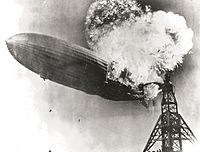
In 1937, the German zeppelin Hindenburg exploded over Lakehurst Naval Air Station in Manchester. As it approached a mooring mast, the hydrogen-filled zeppelin suddenly caught fire. Within 34 seconds, it was completely engulfed in flames. 36 people died, most by jumping from the burning ship. The Hindenburg had completed a year of successful trips before the fire. The cause of the explosion is still debated today.
World War II and the 1940s
New Jersey shipyards built many naval ships during World War II, including battleships and aircraft carriers. The state received 9% of all war-related contracts. Nearly 500,000 New Jersey residents joined the military, which was more than 10% of the state's population. Many women took jobs in factories while their husbands were away fighting.
Camp Kilmer near New Brunswick was a staging area for soldiers going to the port of New York. It provided medical care and supplies. Camp Kilmer was used again for the Korean War and the 1956 Hungarian Revolution. Fort Dix was reopened to train soldiers for the war. During the war, Naval Weapons Station Earle in Monmouth County was opened to build naval supplies and provide a safe port for ships to get ammunition.
Millville Airport opened in 1941. It was called "America's First Defense Airport" because it trained fighter pilots. Over 1,500 pilots learned advanced aircraft fighting there. Fort Hancock was also opened in Sandy Hook. Gunners at the fort stopped German submarines from entering New York Harbor. The airfield, now known as McGuire Air Force Base, was expanded during the war and became an Air Force base in 1949.
In 1945, a dramatic event happened off the New Jersey coast: U.S. forces sank a German U-boat (U-869). The Coast Guard station at Sandy Hook Gateway Park was staffed throughout the war to protect New York harbor.
An internment camp for people of Japanese, German, and Italian descent was located in Gloucester City. Also, Seabrook Farms used Japanese-American workers from internment camps to increase production. After World War II, the internment camps closed, but many people from the camps continued to work at Seabrook Farms.
In 1947, the current New Jersey State Constitution was approved. It reorganized the state government. Governors could now serve four-year terms instead of three. The Legislature was set up with a 40-member Senate and an 80-member General Assembly. The new Constitution also gave voting rights back to women and non-white people.
Late 20th Century
In the 1950s, the Port Authority of New York and New Jersey built the Port Newark-Elizabeth Marine Terminal in Newark and Elizabeth. This was the first port in the world to use shipping containers, thanks to Malcom McLean and the Sea-Land Corporation. This new port quickly made older docks in Brooklyn, Manhattan, and Hoboken less useful. By 1985, it was the busiest port in the world.
During the 1960s, many African Americans felt they were not treated fairly. Poor city conditions, fewer factory jobs, and unfair police practices made these feelings worse. This tension led to social unrest. The first major unrest happened in Jersey City on August 2, 1964, causing much damage. Similar events happened in Paterson and Elizabeth from August 11 to 13, 1964.
In the summer of 1967, urban residents, mainly African Americans, had five days of unrest in Newark and Plainfield. Twenty-four people died, and nearly 1,600 were arrested. These events are often seen as a major reason for the decline of Newark and its nearby communities. Many residents who could afford to, moved to the suburbs after these events.
In the middle of the Cold War, from June 23 to June 25, 1967, President Lyndon B. Johnson met with Soviet Premier Alexei Kosygin in Glassboro, New Jersey, at Glassboro State College. No specific agreements were made, especially about missile systems. However, the meeting helped improve the difficult relationship between the Soviet Union and the U.S.
Because of its important location on the East Coast, New Jersey played a key role in the U.S. defense during the Cold War. Fourteen Nike anti-aircraft missile batteries were built in New Jersey. These were meant to protect the areas around Philadelphia and New York City. A regional command center was also built in New Jersey. By 1974, these missile sites were closed. Other defense sites, like radar stations and air bases, were built to protect against a possible attack from Soviet aircraft.
In 1973, the New Jersey Supreme Court ordered the state government to fund schools more fairly for poorer areas. The government passed a law in 1975 but didn't provide the money. So, in 1976, the Court closed all public schools for eight days until the government passed an income tax bill. Before this, New Jersey had no income tax.
In 1998, the south side of Ellis Island came under New Jersey's control after a U.S. Supreme Court decision. Before this, New York had governed the island. Now, New Jersey and New York share control over the island.
New Jersey in the 21st Century
Terrorist Attacks
In the September 11, 2001, attacks, hijackers took control of four U.S. airplanes. One of these, United Airlines Flight 93, left from Newark International Airport. The attacks caused 2,986 deaths, including about 700 New Jersey residents. Over 160,000 people were evacuated by ferries and boats from Manhattan to New Jersey because subway and train stations were closed.
The destruction of offices in Lower Manhattan sped up a trend of jobs moving from Lower Manhattan to Midtown and New Jersey. The Goldman Sachs Tower was built in Jersey City as part of this move. New Jersey towns, like Middletown, which lost many residents in the attacks, suffered greatly.
For several weeks starting on September 18, 2001, letters with a Trenton, New Jersey postmark were sent to news media offices and two U.S. Senators. These letters contained anthrax bacteria. It was later found that a scientist from Maryland had mailed them.
Images for kids
-
Military map by William Faden with troop movements during the Ten Crucial Days
-
Molly Pitcher taking over her husband's position at a cannon




